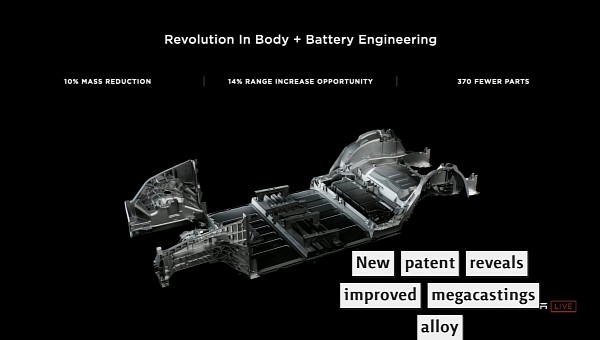Tesla has strengthened its intellectual property portfolio with many patent applications filed in the past months. The latest patent application shows improvement to the aluminum alloy used to cast the front megacastings.
Tesla might be known as the company that started the EV revolution, but it’s much more than that. Many consider that building cars is easy, and established carmakers should have no problem pushing Tesla off the market. In reality, legacy automakers are more likely to find excuses not to ramp up their EV production than surpass Tesla, despite bold claims here and then. Every other carmaker producing electric vehicles is losing money with every car sold, so there must be something that Tesla does differently.
And indeed, there is. By thinking outside the box, Tesla improved many aspects of car manufacturing. The EV maker produces most components in-house, unlike the other car manufacturers, which use third-party suppliers for almost everything. It’s less known, but Tesla even makes the seats for its cars, following a bad experience with supplied seats for the Model S ten years ago. This level of vertical integration allows it to optimize every component for productivity and costs without waiting for a partner to change its production.
Tesla’s biggest contribution to the automotive industry is not the electric drivetrain, the batteries, or the EV as a whole. Instead, it’s the car architecture and how vehicles are assembled. Tesla surprised everyone when it introduced the single-piece megacastings into the Model Y structure. The die-cast structures are said to replace dozens of individual metal parts that need to be welded or bonded in traditional car manufacturing.
The single-piece megacastings make producing a car’s body as straightforward as possible. Strap two such structures to the battery pack, and you have the best body structure possible. It only needs the body sides and the roof, and the body-in-white is complete. Megacastings can be produced very quickly, saving more time. It’s part of why Tesla can be profitable while others still lose money.
The megacastings are a great invention, but being structural parts, they sometimes require conflicting characteristics. For once, they need to be stiff to ensure body rigidity. On the other hand, they have to be collapsible and absorb the shock in a crash. They need to be ductile, not brittle. Tesla has done a lot of research on the structure and the alloy used in these megacastings.
We’ve seen another Tesla patent describing exactly how the front megacasting in the Tesla Model Y reacts during a crash. Contrary to extrusions and stampings, the megacastings absorb energy by generating progressive deformations and fractures in the casting. That’s why the alloy composition is crucial. Tesla was not satisfied with previous results and is now changing the aluminum alloy composition used to cast the megacastings.
Based on a recent patent filing, the new alloy offers a yield strength of at least 130 MPa and a bend angle of at least 20 degrees at a 3 mm section thickness when as-cast and without further processing. The filing covers not only composition but also the casting technique to achieve the required characteristics. Based on this, the material can achieve even higher specs in some departments. In certain configurations, it doesn’t need further processing, which shortens production time and cuts costs.
And indeed, there is. By thinking outside the box, Tesla improved many aspects of car manufacturing. The EV maker produces most components in-house, unlike the other car manufacturers, which use third-party suppliers for almost everything. It’s less known, but Tesla even makes the seats for its cars, following a bad experience with supplied seats for the Model S ten years ago. This level of vertical integration allows it to optimize every component for productivity and costs without waiting for a partner to change its production.
Tesla’s biggest contribution to the automotive industry is not the electric drivetrain, the batteries, or the EV as a whole. Instead, it’s the car architecture and how vehicles are assembled. Tesla surprised everyone when it introduced the single-piece megacastings into the Model Y structure. The die-cast structures are said to replace dozens of individual metal parts that need to be welded or bonded in traditional car manufacturing.
The single-piece megacastings make producing a car’s body as straightforward as possible. Strap two such structures to the battery pack, and you have the best body structure possible. It only needs the body sides and the roof, and the body-in-white is complete. Megacastings can be produced very quickly, saving more time. It’s part of why Tesla can be profitable while others still lose money.
The megacastings are a great invention, but being structural parts, they sometimes require conflicting characteristics. For once, they need to be stiff to ensure body rigidity. On the other hand, they have to be collapsible and absorb the shock in a crash. They need to be ductile, not brittle. Tesla has done a lot of research on the structure and the alloy used in these megacastings.
We’ve seen another Tesla patent describing exactly how the front megacasting in the Tesla Model Y reacts during a crash. Contrary to extrusions and stampings, the megacastings absorb energy by generating progressive deformations and fractures in the casting. That’s why the alloy composition is crucial. Tesla was not satisfied with previous results and is now changing the aluminum alloy composition used to cast the megacastings.
Based on a recent patent filing, the new alloy offers a yield strength of at least 130 MPa and a bend angle of at least 20 degrees at a 3 mm section thickness when as-cast and without further processing. The filing covers not only composition but also the casting technique to achieve the required characteristics. Based on this, the material can achieve even higher specs in some departments. In certain configurations, it doesn’t need further processing, which shortens production time and cuts costs.










